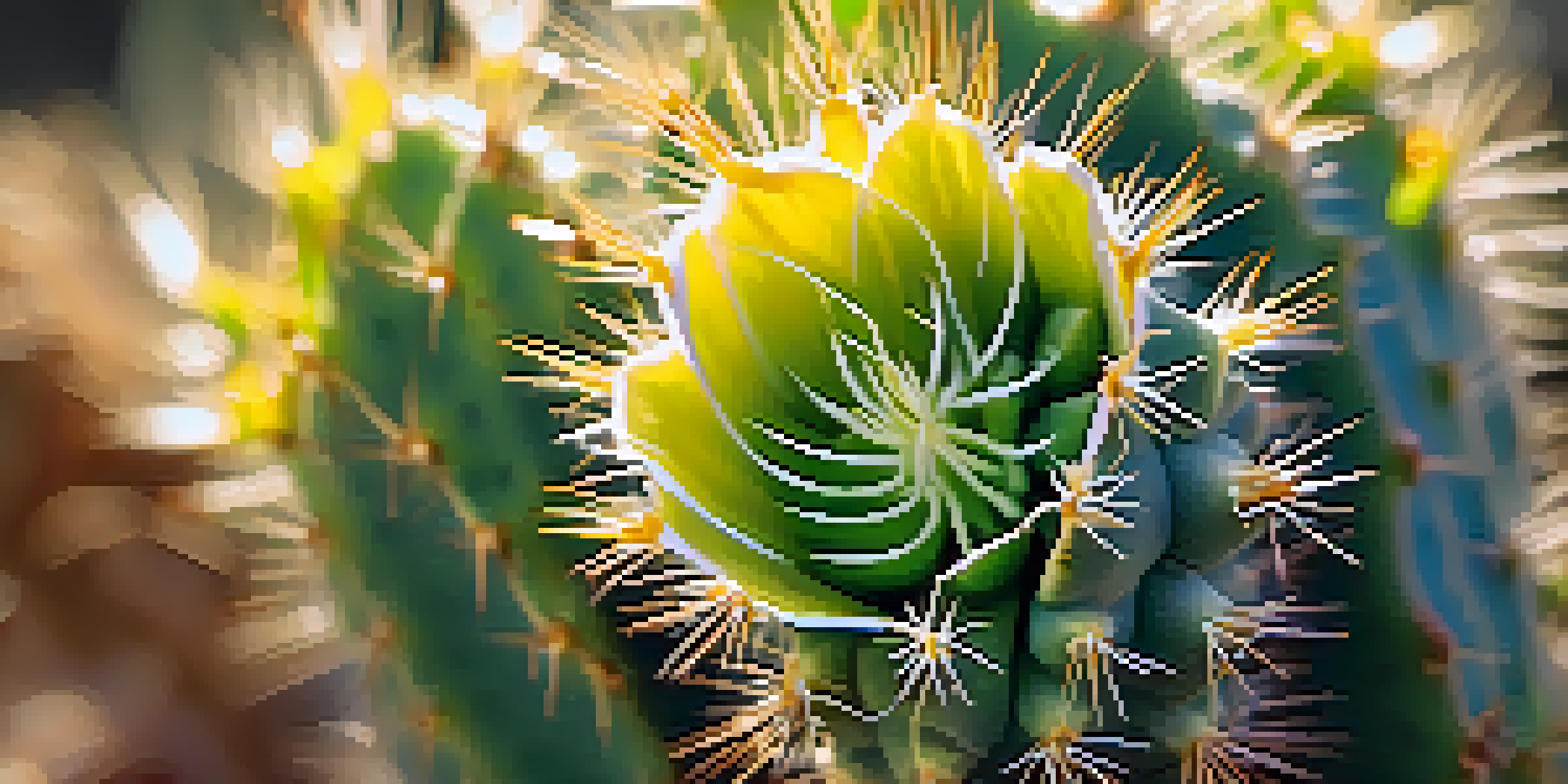Peyote's Chemical Composition: Implications for Future Studies

Understanding the Basics of Peyote's Chemical Composition
Peyote, a small cactus native to Mexico and the southwestern United States, contains a variety of psychoactive compounds. The primary ingredient that garners interest is mescaline, a hallucinogenic alkaloid responsible for the cactus's mind-altering effects. However, Peyote's chemical composition extends beyond just mescaline, including other alkaloids that might influence its overall effects.
The greatest discovery of my generation is that a human being can alter his life by altering his attitude.
Researchers are increasingly curious about these additional compounds, which include nor-mescaline, anhalonine, and various other alkaloids. Each of these components may interact differently with the human body, potentially leading to a wide array of psychological and physiological responses. Understanding these interactions is key to unlocking the full potential of Peyote in both therapeutic and cultural contexts.
This foundational knowledge sets the stage for deeper exploration into how these compounds work together, creating a unique experience for users. As studies advance, recognizing the full spectrum of Peyote's chemical makeup will be crucial for both scientific and traditional uses.
The Role of Mescaline in Peyote's Effects
Mescaline is the most well-known psychoactive component of Peyote, celebrated for its ability to induce vivid visual and auditory hallucinations. This compound is a serotonin receptor agonist, meaning it binds to serotonin receptors in the brain, leading to altered perceptions and enhanced emotional experiences. Due to its effects, mescaline has been used for centuries in religious and spiritual practices among Indigenous communities.

Studies suggest that mescaline may also have therapeutic benefits, such as alleviating symptoms of anxiety and depression. Its ability to foster a sense of connection and introspection makes it a potential candidate for research into mental health treatments. However, the exact mechanisms through which mescaline operates in the brain remain a topic of ongoing investigation.
Mescaline's Role in Peyote Effects
Mescaline, the primary psychoactive compound in Peyote, interacts with serotonin receptors, leading to altered perceptions and potential therapeutic benefits.
Understanding how mescaline interacts with other components of Peyote could provide valuable insights into its efficacy and safety for therapeutic use. This could pave the way for new treatment modalities in psychiatry, emphasizing the importance of comprehensive studies on Peyote's chemical profile.
Exploring the Synergistic Effects of Peyote's Alkaloids
While mescaline often takes center stage in discussions about Peyote, the presence of other alkaloids suggests a more complex interaction at play. These alkaloids may work in synergy with mescaline, enhancing or modifying its effects. For example, the alkaloid anhalonine has shown potential psychoactive properties that could influence the overall experience of consuming Peyote.
The only way to make sense out of change is to plunge into it, move with it, and join the dance.
Research into these synergistic effects could reveal how various components of Peyote contribute to its psychoactive profile. This not only enhances our understanding of Peyote's traditional uses but also informs future clinical applications. By examining how these compounds interact, scientists can gain insights into optimizing dosage and enhancing therapeutic outcomes.
Exploring these interactions is crucial for developing a holistic understanding of Peyote. As researchers continue to delve into its chemical composition, the potential for discovering new therapeutic applications remains vast.
Implications for Indigenous Practices and Cultural Significance
Peyote holds deep spiritual and cultural significance for many Indigenous communities, particularly in Mexico and the United States. The traditional use of Peyote in religious ceremonies underscores its role not only as a psychoactive substance but also as a means of fostering community and spiritual connection. Understanding its chemical composition can empower these communities by validating their practices through scientific inquiry.
As research uncovers the unique properties of Peyote and mescaline, it can bridge the gap between traditional knowledge and modern science. This collaboration can lead to a greater appreciation of the cultural contexts in which Peyote is used, highlighting its importance beyond mere recreational use. Moreover, recognizing the ethical implications of such research is crucial in respecting Indigenous rights and knowledge.
Synergistic Alkaloid Interactions
Different alkaloids in Peyote, such as anhalonine, may work together with mescaline, creating a complex psychoactive experience that warrants further research.
By acknowledging these cultural dimensions alongside scientific exploration, the future study of Peyote can be more inclusive and respectful. This holistic approach can help ensure that Indigenous voices are central in the discussions surrounding this sacred plant.
Ethical Considerations in Peyote Research
As interest in Peyote's chemical composition grows, so do the ethical considerations surrounding its research. Issues such as cultural appropriation, the rights of Indigenous peoples, and the environmental impact of harvesting Peyote must be carefully navigated. Ethical research practices are essential to ensure that the benefits of scientific exploration do not come at the expense of the very communities that have nurtured this plant for generations.
One way to address these concerns is by involving Indigenous communities in the research process. Collaborating with these communities can provide essential insights and ensure that their knowledge and traditions are respected. This approach not only honors their cultural heritage but also enhances the legitimacy and relevance of the research findings.
Establishing ethical guidelines and frameworks for studying Peyote will be vital as interest in its chemical properties continues to grow. A responsible approach ensures that future studies are conducted with integrity, benefiting both science and the communities that hold Peyote sacred.
The Future of Peyote Research: Opportunities and Challenges
The future of Peyote research is filled with promise, especially as attitudes toward psychedelics shift in society. There is a growing acceptance of the potential benefits these substances can offer, particularly in mental health treatment. This trend opens the door for more comprehensive studies into Peyote's chemical composition and its implications for therapy and spiritual practices.
However, challenges remain, including legal restrictions and the need for robust scientific methodologies. Researchers must navigate a complex regulatory landscape that can hinder progress. Additionally, ensuring that studies are designed to provide meaningful results while addressing individual variations in response to Peyote is crucial.
Cultural and Ethical Research Issues
Research on Peyote must respect Indigenous traditions and involve community collaboration to ensure ethical practices and cultural integrity.
Despite these hurdles, the potential for discovering new therapeutic applications and enhancing our understanding of this unique cactus is substantial. With continued advocacy and research, Peyote may play a significant role in the future of mental health treatment and spiritual exploration.
Conclusion: The Importance of Understanding Peyote's Composition
In conclusion, understanding Peyote's chemical composition is not just an academic exercise; it has real-world implications for therapy, cultural preservation, and ethical research. The insights gained from studying its alkaloids can unlock new pathways for mental health treatment while respecting the traditions of Indigenous communities. As we move forward, a balanced approach that honors both science and culture will be essential.
The future of Peyote research promises exciting possibilities, from therapeutic breakthroughs to a deeper appreciation of its role in Indigenous spirituality. By prioritizing ethical considerations and collaborative efforts, we can ensure that the benefits of this research are shared equitably. The journey into Peyote's chemistry is just beginning, and its potential impact is vast.

Ultimately, as we continue to explore the complexities of Peyote's composition, we open doors to understanding not just the cactus itself but also the intersection of culture, science, and humanity. The implications of this research extend far beyond the lab, influencing how we view and interact with the world around us.